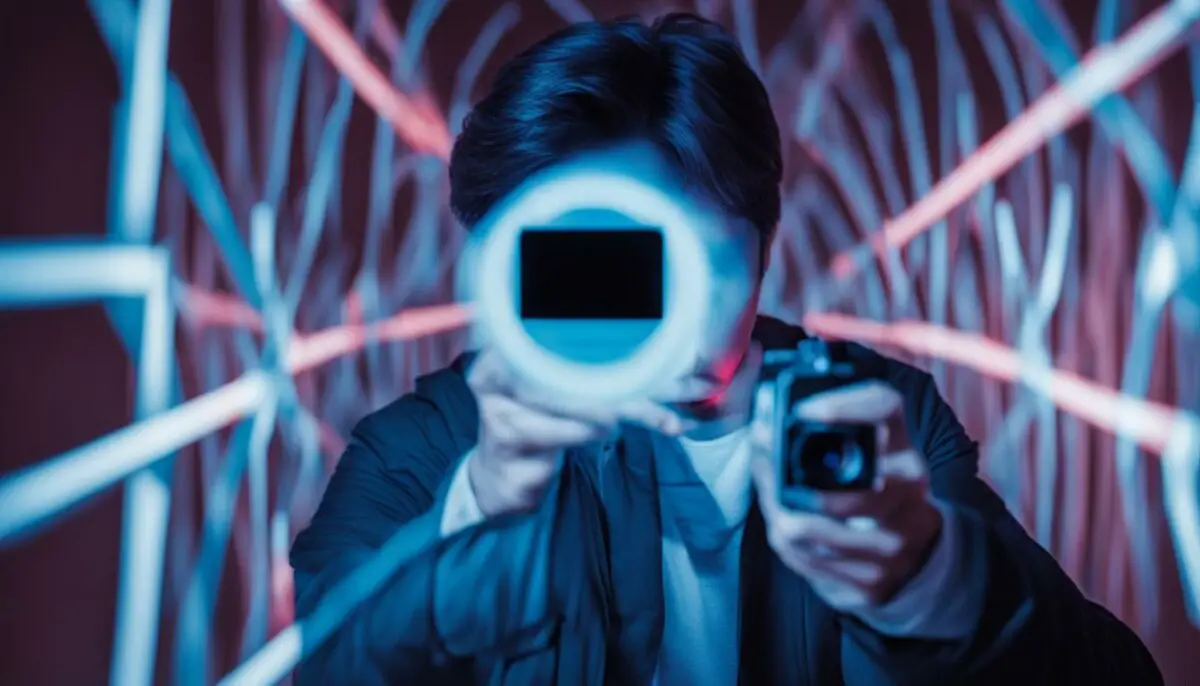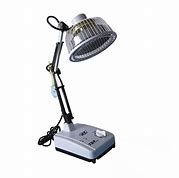Last Updated on 6 months by Francis
Infrared camera technology has come a long way in recent years, and while it has many valuable applications, it can also be used for intrusive surveillance. Fortunately, there are simple steps you can take to protect your privacy and block infrared cameras from detecting or tracking you.
In this section, we will provide an overview of infrared camera blocking techniques and explain how to use them effectively. Whether you’re concerned about your privacy at home, in public, or at work, these tips can help you stay protected.
Contents
Key Takeaways
- Understanding infrared camera technology is essential to effectively blocking them
- Assess your specific privacy needs before implementing any blocking techniques
- Physical barriers and obstacles can be effective in obstructing the view of infrared cameras
- Infrared-reflective materials can be used to maintain your privacy
- Be aware of legal considerations and ethical use of techniques to block infrared cameras
Understanding Infrared Camera Technology
To effectively block infrared cameras, it’s important to have a basic understanding of how they work and how they detect heat. Infrared cameras use infrared radiation to create images of the surrounding environment. This allows them to visualize heat and identify objects that are not visible to the naked eye.
Interference is a common issue with infrared cameras as they can detect even the slightest heat sources. This means that simply blocking the camera’s view may not be enough to prevent detection.
Infrared Camera Interference
Infrared cameras can be disturbed by sources of heat that disrupt their detection capabilities. These sources can be natural or artificial, and include things like sunlight, bright lights, or other infrared-emitting devices.
The effectiveness of interference techniques varies depending on the type of camera and the specific environment in which it operates. To block infrared cameras effectively, it’s crucial to consider interfering with the camera’s detection mechanism, not just blocking its view.
Infrared Camera Detection Prevention
One common method of infrared camera detection prevention is the use of infrared-absorbing materials. These materials can block the radiation emitted by the camera, making it difficult to detect heat sources. This approach can be particularly effective in outdoor settings where there are fewer available options for physical barriers.
Another method is the use of infrared camera jammers. These devices emit signals that interfere with the camera’s ability to detect heat sources. While they can be effective, it’s important to use them in compliance with local laws as they may be illegal in some regions.
Assessing Your Privacy Needs

Before you begin implementing any of the infrared camera blocking techniques, it’s important to assess your specific privacy needs. Factors to consider include the level of surveillance in your area and the importance of protecting your privacy.
Once you have determined your privacy needs, you can then choose the best infrared camera shielding methods to protect against infrared camera surveillance. These methods can range from physical barriers and obstacles to infrared-reflective materials and camouflage techniques.
It’s crucial to remember that no single method can fully guarantee your privacy, and the most effective approach is often a combination of different techniques tailored to your specific needs.
Assessing Your Privacy Needs Checklist:
- Determine the level of surveillance in your area
- Evaluate the importance of protecting your privacy
- Consider the range of infrared cameras in the area and their capabilities
- Assess your specific privacy needs and choose the best infrared camera shielding methods accordingly
Remember, protecting your privacy is a fundamental right, and taking steps to safeguard it is always a wise decision.
Physical Barriers and Obstacles

If you want to block infrared cameras, creating physical barriers is an effective approach. Infrared cameras rely on line-of-sight detection, so by obstructing their view, you can effectively prevent them from detecting you. Let’s take a look at some effective ways to create physical barriers:
Using Obstacles
Infrared cameras cannot see through glass or other opaque materials. By placing objects or obstacles, such as curtains, blinds, or cardboard boxes in front of infrared cameras, you can block their view. This method is particularly effective for blocking cameras that are stationary or mounted in one place.
Wearing Infrared-Reflective Clothing
Infrared-reflective clothing is designed to reflect the infrared radiation that cameras use to detect objects. By wearing clothing made from these materials, you can make it difficult for cameras to detect you. Infrared-reflective clothing is also comfortable to wear and comes in many different styles and colors.
Building Walls or Fences
If you want to block infrared cameras from detecting you on your property, consider building walls, fences, or other physical barriers. These obstacles will block the camera’s line of sight and make it difficult for them to detect you. Walls or fences made from materials that are opaque to infrared radiation are particularly effective.
If you’re looking for a discreet option, you can use plants or shrubs to create a natural barrier that will block the camera’s view.
Using Infrared-Blocking Films on Windows
Infrared-blocking films are a great option for obstructing the view of infrared cameras. These films are designed to block infrared radiation while still allowing visible light to pass through. You can use these films on windows to make it difficult for cameras to detect you inside your home or office.
Countermeasures for Infrared Camera Spying
In addition to creating physical barriers, there are other countermeasures you can use to prevent infrared cameras from spying on you. For example, you can use infrared camera interference devices that emit signals that disrupt the functionality of infrared cameras. Another option is to use camouflage and concealment techniques to remain undetected by cameras.
By using these infrared camera blocking techniques, you can keep your privacy intact and prevent unwanted surveillance.
Using Infrared Camera Jammers
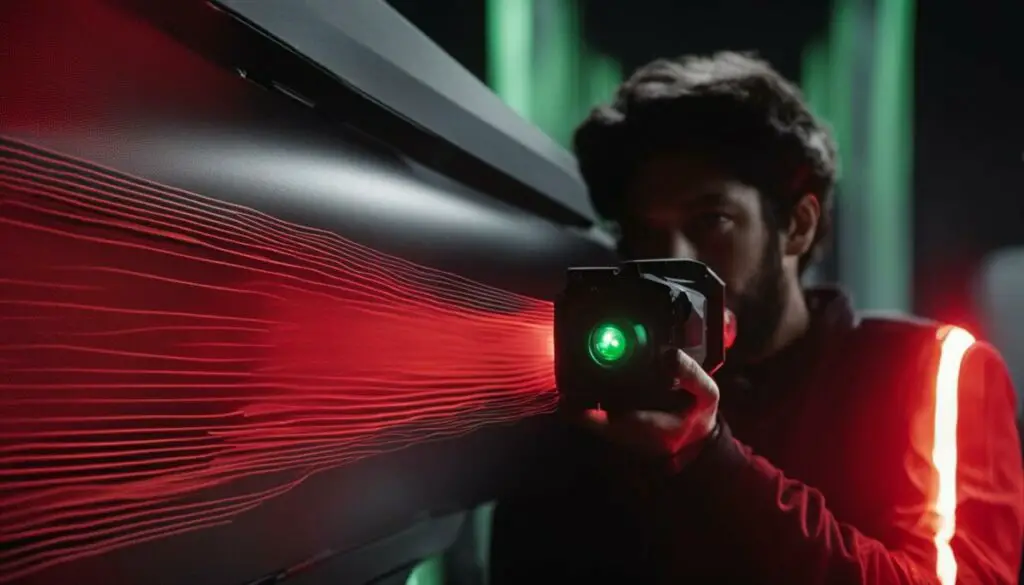
Another effective technique to block infrared cameras is by using infrared camera jammers. These devices emit signals that interfere with the infrared detection capabilities of cameras, rendering them useless.
How does it work? Infrared camera jammers function by emitting a signal that overwhelms the infrared sensor of the camera, effectively blocking its ability to detect heat signatures and other infrared sources in its vicinity. This causes the camera to malfunction and can even shut it down entirely.
When using an infrared camera jammer, it’s important to aim the device towards the camera you want to block. Keep in mind that the effectiveness of these jammers can vary depending on factors such as the distance between the jammer and the camera, the strength of the signal emitted by the jammer, and other environmental factors.
It’s also worth noting that the use of infrared camera jammers may be illegal in some jurisdictions, and their use may be subject to penalties and fines. Before using a jammer, it’s important to research local laws and regulations and ensure that you are using the device in a responsible and ethical manner.
Tips for using infrared camera jammers:
- Research local laws and regulations before using a jammer
- Aim the jammer towards the camera you want to block
- Keep in mind that environmental factors can affect the effectiveness of the jammer
- Use the jammer responsibly and ethically
“Infrared camera jammers are particularly useful in situations where you need to protect your privacy quickly and discreetly. However, it’s important to use these devices responsibly and in accordance with local laws and regulations.”
Infrared-Reflective Materials
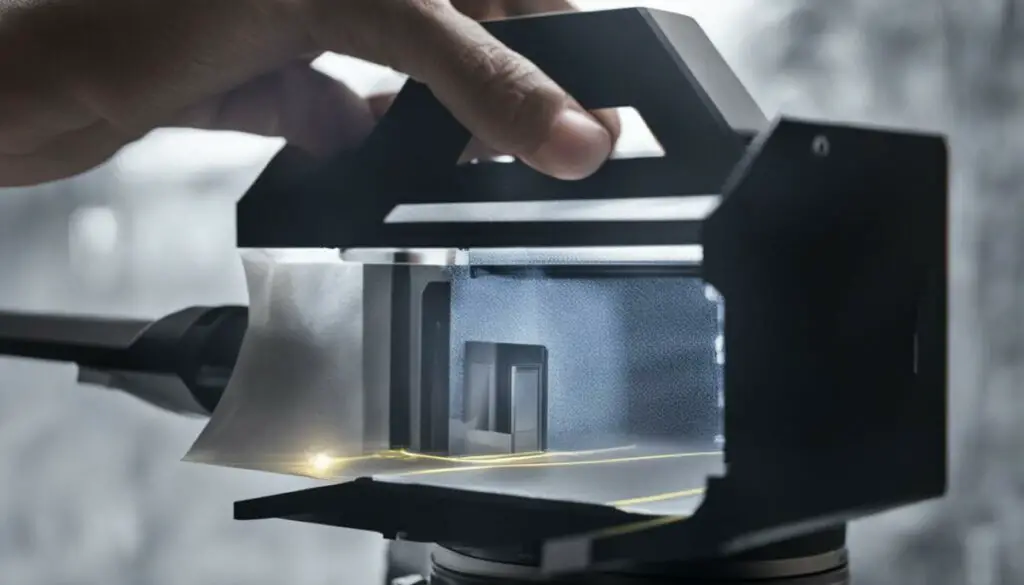
Another effective way to block infrared cameras is by using infrared-reflective materials. These materials reflect the infrared radiation emitted by objects, which can make it challenging for infrared cameras to detect them. Commonly used materials include glass, mirrors, and special films that can be applied to surfaces.
One popular type of infrared-reflective film is the 3M Prestige Series, which is designed for use on windows. This film reflects up to 97% of infrared radiation and blocks up to 99.9% of harmful UV rays. It also allows for natural light transmission and has a low reflectivity, so it won’t obscure your view.
To effectively shield an area, you’ll need to apply the film to all windows and surfaces in the space. This can be a costly and time-consuming process, but it can provide reliable protection against infrared camera surveillance.
Camouflage and Concealment Techniques
If you’re looking for a more subtle approach to block infrared cameras, camouflage and concealment techniques can be incredibly effective. By blending into your surroundings, you make it difficult for infrared cameras to detect or track you.
A simple way to camouflage yourself is by wearing clothing that matches the color and pattern of your environment. For example, if you’re in a wooded area, wear clothing with a woodland camo pattern. Additionally, you can use natural materials, like leaves and branches, to cover yourself and break up your silhouette.
When it comes to concealing yourself, it’s important to stay low and avoid areas of high infrared activity. Thermal imaging cameras are often used to detect body heat, so finding a cool spot or staying in the shade can help reduce your thermal signature.
Another technique to consider is using infrared-absorbing materials. These materials are designed to absorb infrared energy and reduce your thermal signature, making it more difficult for infrared cameras to track you. Clothing made with these materials is becoming more widely available, and can be a great option for those looking to maintain their privacy.
“Camouflage and concealment techniques can be employed to make it difficult for infrared cameras to detect or track you.”
In short, by blending in with your surroundings and reducing your thermal signature, you can effectively protect yourself against infrared camera surveillance.
Infrared Camera Interference Devices
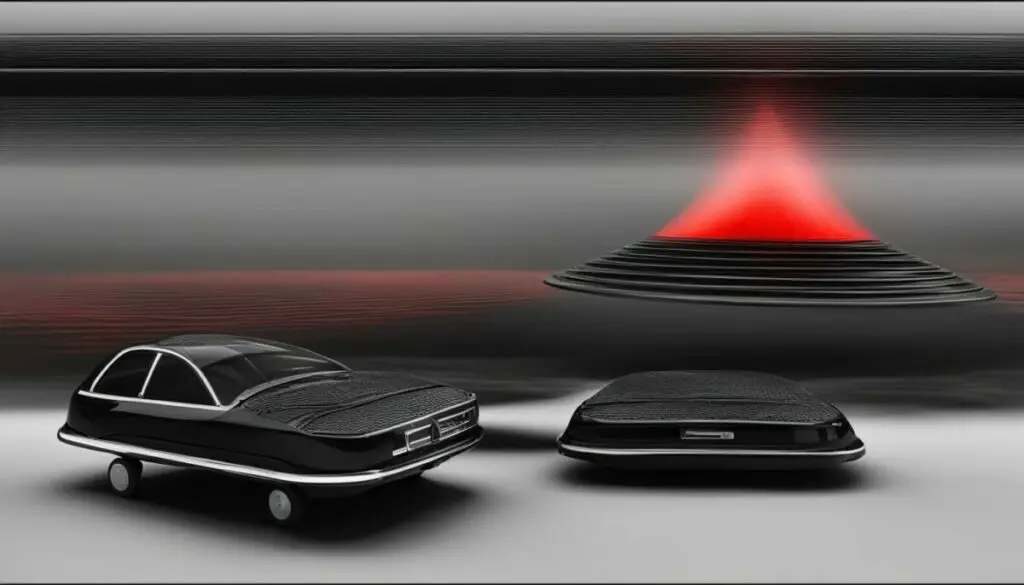
If physical barriers and infrared-reflective materials aren’t suitable for your needs, then infrared camera interference devices may be the solution for you. These devices emit signals that can disrupt the functionality of infrared cameras and prevent them from detecting or tracking you.
There are various types of infrared camera interference devices available, including:
| Device Type | Description |
|---|---|
| Infrared Flood Lights | These devices emit a bright light that can overwhelm the sensors in infrared cameras, making it difficult for them to detect objects or people. |
| Infrared Flashlight Jammers | Similar to regular flashlights, these devices emit a bright light that can interfere with the detection capabilities of infrared cameras by flooding the frame with excess light. |
| Infrared Laser Jammers | These devices emit infrared light that can interfere with the detection capabilities of infrared cameras. They work by flooding the frame with bright light, making it difficult for cameras to detect anything else in the vicinity. |
When choosing an infrared camera interference device, it’s important to consider the specific needs of your situation. Some devices may be more effective than others depending on the type of camera you’re trying to block and the environment in which you’re using them.
It’s also important to note that the use of infrared camera interference devices may be subject to legal restrictions in certain areas. Be sure to check with local regulations and laws before using them.
Infrared Camera Detection Prevention Apps

Mobile apps can be a useful tool in detecting and preventing the intrusion of infrared cameras. These apps work by using your smartphone’s camera sensor to detect infrared light. They can alert you if an infrared camera is in use nearby, enabling you to take necessary precautions to protect your privacy.
One popular app for Android is the Hidden Camera Detector app, which scans for hidden cameras using your phone’s magnetic sensor. The app can detect not only infrared cameras but also other types of concealed cameras.
For iPhone users, the Hidden Camera Detector app is also available, which uses the iPhone’s camera to detect the presence of hidden cameras. Another app, the Hidden Device Detector, can detect hidden cameras as well as other spying devices such as microphones and GPS trackers.
It is important to note that these apps may not be able to detect all types of infrared cameras, and the accuracy of the detection can vary. However, they can still be a useful tool in detecting and preventing infrared camera surveillance in certain situations.
Tip: Be cautious when downloading hidden camera detection apps as some may contain malware or viruses. Only download apps from trusted sources and read reviews before installing.
Infrared Camera Privacy and Detection Prevention

As you explore various techniques to block infrared cameras, it’s important to be aware of the legal and ethical considerations of their use. While protecting your privacy is essential, it should not come at the expense of violating someone else’s rights or engaging in illegal behavior.
It’s important to understand the laws surrounding the use of infrared cameras in your region. In the United States, for example, laws vary from state to state, and some areas may have stricter regulations than others regarding the use of infrared cameras for surveillance purposes.
Additionally, it’s important to consider the potential consequences of interfering with infrared cameras. While there may be certain situations where blocking an infrared camera is necessary for protection, it’s important to use these techniques responsibly and with discretion.
Finally, consider the ethical implications of using techniques to block infrared cameras. While these cameras can potentially infringe on your privacy, they can also serve a legitimate purpose in security and law enforcement contexts. As you assess your privacy needs and consider different methods of blocking infrared cameras, be sure to do so in a responsible and ethical manner.
Protecting Your Infrared Camera Privacy
To protect your privacy against infrared cameras, consider employing a variety of different techniques. This may include using physical barriers, infrared-reflective materials, or infrared camera jammers.
It’s also important to assess your specific privacy needs and choose the techniques that are most appropriate for your situation. For example, those living in areas with high levels of infrared camera surveillance may require more extensive measures than those in areas with less surveillance.
Finally, consider using a mobile app designed to detect and prevent the intrusion of infrared cameras. These apps can help you stay informed about potential surveillance and take action to protect your privacy.
“While protecting your privacy is essential, it should not come at the expense of violating someone else’s rights or engaging in illegal behavior.”
By taking a thoughtful and responsible approach to blocking infrared cameras, you can enjoy greater privacy and peace of mind in your daily life.
Tips for Maintaining Privacy in Everyday Life
Infrared camera surveillance is becoming increasingly common, and it’s important to take steps to protect your privacy in your daily life. Here are some practical tips:
- Be aware of your surroundings and look for any cameras that may be present.
- Wear clothing made of infrared-reflective materials to make it difficult for infrared cameras to detect you.
- Avoid carrying any items that may reflect infrared light, such as mirrors or shiny objects.
- Use infrared camera detection prevention apps on your smartphone to alert you to the presence of any infrared cameras nearby.
- Consider using physical barriers to block the view of infrared cameras, such as curtains or blinds.
- Use camouflage and concealment techniques, such as blending into crowds or wearing clothing that matches your surroundings.
- Be cautious of using infrared camera interference devices or jammers, as they may be illegal in some areas.
By following these tips and being vigilant in your daily life, you can protect yourself against infrared camera surveillance and maintain your privacy.
Conclusion
Protecting your privacy is crucial in today’s world, and blocking infrared cameras is an important step towards achieving that goal. By implementing the techniques discussed in this guide, you can safeguard yourself against unwanted surveillance and enjoy peace of mind.
Stay Informed
It’s important to keep up-to-date with the latest advancements in infrared camera technology and surveillance tactics. By remaining informed, you can adjust your privacy measures accordingly and stay one step ahead of potential threats.
Be Mindful of Legal and Ethical Considerations
While it is essential to maintain your privacy, it’s also crucial to be mindful of the legal considerations and ethical use of blocking techniques. Always ensure that your methods do not violate any laws or ethical standards and that you use them responsibly.
Implement Everyday Privacy Practices
Finally, it’s essential to implement everyday privacy practices to protect yourself in various settings where infrared camera surveillance may be a concern. For example, be mindful of your surroundings, avoid sharing personal information, and be cautious when entering private spaces.
By following these guidelines and implementing the techniques outlined in this guide, you can take proactive measures to protect your privacy and maintain your security in today’s interconnected world.
FAQ
How do infrared cameras work?
Infrared cameras detect infrared radiation, which is emitted by all objects with a temperature above absolute zero. They capture this radiation and convert it into an image that we can see.
Can infrared cameras see through walls?
No, infrared cameras cannot see through walls. They can only detect the infrared radiation emitted by objects that are in the line of sight of the camera.
How can I block an infrared camera?
There are several techniques you can use to block infrared cameras, such as creating physical barriers, using infrared camera jammers, or using infrared-reflective materials.
Are there any legal considerations when blocking infrared cameras?
It’s important to be aware of the legal considerations surrounding the use of techniques to block infrared cameras. Make sure to familiarize yourself with the laws in your jurisdiction and ensure that your actions comply with them.
Can I use infrared camera blocking techniques in public places?
While it’s generally legal to use infrared camera blocking techniques on your own property, using them in public places may have legal implications. Always check local laws and regulations before employing any blocking techniques in public areas.
Are there any apps to detect infrared cameras?
Yes, there are mobile apps available that can help detect the presence of infrared cameras. These apps use the phone’s built-in sensors to detect infrared radiation. However, their accuracy may vary, so it’s important to use them as an additional tool rather than solely relying on them.

